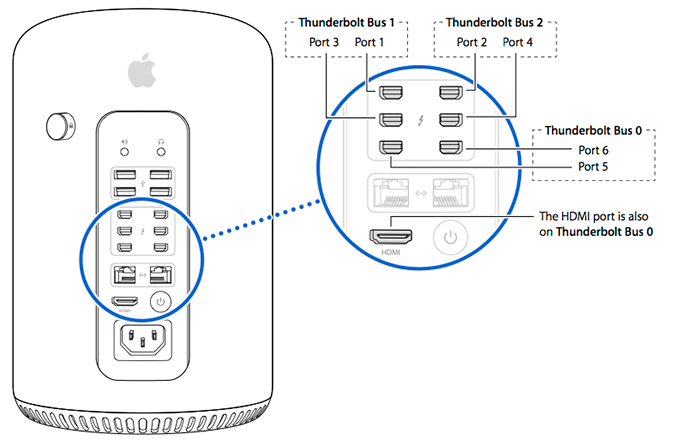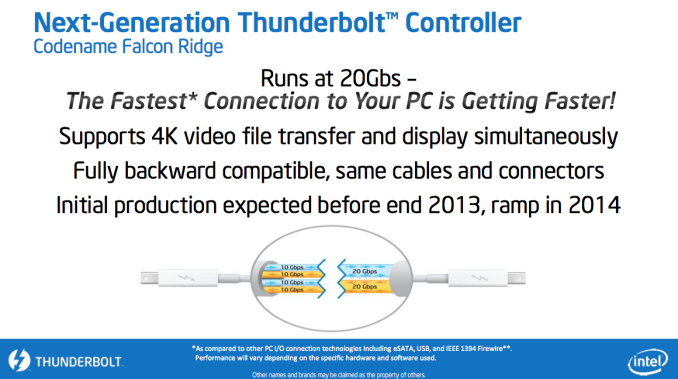The Mac Pro Review (Late 2013)
by Anand Lal Shimpi on December 31, 2013 3:18 PM ESTThunderbolt 2
The new Mac Pro integrates three Intel Falcon Ridge Thunderbolt 2 controllers. These are the fully configured controllers, each supporting and driving two Thunderbolt 2 connectors on the back of the Pro for a total of 6 ports.
Pairing Thunderbolt 2 with Ivy Bridge EP is a bit tricky as Apple uses Thunderbolt 2 for display output as well as data. Typically you’d route all display through processor graphics, but in the case of IVB-EP there is no integrated graphics core. On a DIY PC you enable display output over Thunderbolt 2 by running an extra cable out of the discrete GPU and into a separate input that muxes the signal with PCIe and ships it out via another port as Thunderbolt. Here’s where Apple’s custom PCB work comes in handy as all of this is done internal to the Mac Pro. The FirePro’s display outputs are available via any two of the six Thunderbolt 2 ports, as well as the lone HDMI port on the back of the Mac Pro.
How does Thunderbolt 2 differ from the original? For starters, it really would’ve been more accurate to call it Thunderbolt 4K. The interface is fully backwards compatible with Thunderbolt 1.0. You can use all previous Thunderbolt peripherals with the Mac Pro. What’s new in TB2 is its support for channel bonding. The original Thunderbolt spec called for 4 independent 10Gbps channels (2 send/2 receive). That meant no individual device could get access to more than 10Gbps of bandwidth, which isn’t enough to send 4K video.
Thunderbolt 2 bonds these channels together to enable 20Gbps in each direction. The total bi-directional bandwidth remains at 40Gbps, but a single device can now use the full 20Gbps. Storage performance should go up if you have enough drives/SSDs to saturate the interface, but more importantly you can now send 4K video over Thunderbolt. Given how big of a focus 4K support is for Apple this round, Thunderbolt 2 mates up nicely with the new Mac Pro.
So far I’ve been able to sustain 1.38GB/s of transfers (11Gbps) over Thunderbolt 2 on the Mac Pro. Due to overhead and PCIe 2.0 limits (16Gbps) you won’t be able to get much closer to the peak rates of Thunderbolt 2.

The impact of chaining a 4K display on Thunderbolt 2 downstream bandwidth
Here’s where the six Thunderbolt 2 and three TB2 controllers come into play. Although you can daisy chain a 4K display onto the back of a Thunderbolt 2 storage device, doing so will severely impact available write bandwidth to that device. Remember that there’s only 20Gbps available in each direction, and running a 3840 x 2160 24bpp display at 60Hz already uses over 14Gbps of bandwidth just for display. I measured less than 4Gbps of bandwidth (~480MB/s) available for writes to a Thunderbolt 2 device downstream from the Mac Pro if it had a 4K display plugged in to it. Read performance remained untouched since display data only flows from host to display, leaving a full 20Gbps available for reads. If you’re going to connect Thunderbolt 2 devices to the Mac Pro as well as a 4K display, you’ll want to make sure that they aren’t on the same chain.
If we start numbering in the top left corner of the 2 x 3 array of Thunderbolt ports and go left to right down the stack, you'll want to first populate ports 1, 2 and 5 before filling in the rest. The diagram below should help simplify:












267 Comments
View All Comments
funwithstuff - Wednesday, January 1, 2014 - link
FCP X has been optimised for the Mac Pro and other NLEs haven't — Premiere doesn't make use of twin GPUs yet. Still, to say that "most serious video editor pros have migrated to Premiere" without any numbers or evidence would be a mistake; noise on forums doesn't necessarily translate to real numbers (e.g: http://www.fcp.co/final-cut-pro/news/1294-pbs-surv...Even though I prefer FCP X myself, most features and large-scale TV shows are still cut on Avid, not either of the others.
CalaverasGrande - Wednesday, January 1, 2014 - link
indeed, at our network we are all on Avid (or Dalet).Most Pros I know are on Avid or FCP.
Bill Thompson - Wednesday, January 1, 2014 - link
Final Cut Pro 7 numbers are irrelevant.nedjinski - Wednesday, January 1, 2014 - link
These serious editors love FCP -https://www.youtube.com/watch?v=LxKYuF9pENQ
Bill Thompson - Thursday, January 2, 2014 - link
They liked Premiere Pro 1.0 too.Bill Thompson - Wednesday, January 1, 2014 - link
The biggest issue is CUDA. There are many pro apps that see a huge speed increase with a CUDA compatible GPU (nVidia).Check out Octane, which extends CUDA to lots of apps including Cinema 4D (which makes the cinebench numbers look silly).
If you are using apps that utilize CUDA, a windows PC with nVidia or an iMac would be much faster than the new Mac Pro.
Dug - Monday, January 13, 2014 - link
I would really like to see this. A compilation of new workstations including the Mac Pro, with popular CUDA enhanced apps, non enhanced apps, all benchmarked.newrigel - Wednesday, March 1, 2017 - link
That's pure bullshit I haven't migrated I'll put my shit up against anybody's!!!!!Meaker10 - Tuesday, December 31, 2013 - link
High end notebooks (like the alien ware 17/18) can upgrade the graphics card quite happily.akdj - Wednesday, January 1, 2014 - link
Did you take a wrong turn?